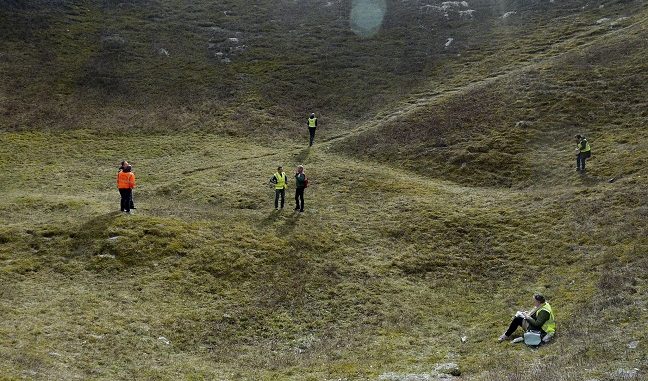
In a new exhibition titled From Wasteland to Wasteland, a group of artists make connections between the power of a First World War site and impact of the war on poet TS Eliot’s modernist masterpiece.
On the first day of the Battle of the Somme in 1916, Captain James Young of the 179th Tunnelling Company, Royal Engineers pressed a switch. He detonated two explosive charges in tunnels under the German front line, starting a battle that left one million men dead or wounded.
Captain Young had blown the mine at La Boisselle, creating a single, vast, smooth sided, flat bottomed crater measuring nearly 100 metres across and 21 metres deep. Now known as the Lochnagar Crater, it is the largest crater ever made by man in anger, and it serves as a unique memorial to all those who suffered in the Great War.
Five years later, after suffering a nervous breakdown, TS Eliot travelled to Margate to rest. Sitting in a seafront shelter, and inspired in part by the horror of the First World War, he wrote his epic poem The Waste Land.
The inspiration
Award-winning printmaker Dawn Cole, who has work in the V&A’s permanent collection, is known for her work exploring stories from the First World War. She visited Lochnagar Crater in 2015.
Inspired by the dramatic site, the manmade landscape, and the stories behind it, she has brought together a small group of artists from Margate to visit the battlefield site, draw connections with TS Eliot’s poem, and make new work as a response. The artists are a diverse group, from different backgrounds and with different practices.
The artists
Portugese artist Helder Clara uses arduous processes to make objects, installations, sculpture, printing, performance, paintings, and photographic documentation. He has exhibited work in Margate and Hastings.
Lorna Dallas-Conte has a fascination with colour and an interest in traditional craft skills. Her work looks at transformation, manifesting energy, and honouring the sacred. As a commended creative business adviser and academic she combines the different strands of her work together seeing their totality as her practice. She has exhibited in London, Surrey and Kent and is a published researcher.
Dan Thompson is an award-winning social artist and writer. Thompson was commissioned to make new work for the first Estuary Festival in 2016, exhibiting alongside John Akomfrah, Jeremy Deller and Adam Chodzko. In 2015 he published a complete history of Stoke, from the Ice Age to thirty years in the future, told through stories he collected on one road and partly inspired by The Waste Land.
Graham Ward is a painter, working in egg tempera and acrylics on board. His work is based on sacred themes, and is strongly influenced by pilgrimages to Santiago de Compostela. Ward studied illustration in Manchester and painting at Stoke. He has exhibited widely in the United Kingdom and Europe, with solo exhibitions in London, Edinburgh, Paris and Berlin.
The exhibition
Supported using public funding by Arts Council England, the five artists travelled together to see the Lochnagar Crater in March 2017. Each artist has made new work in response to the site, and to a subsequent exploration of archives relating to the site.
That work, other relevant work by the artists, and items from First World War archives are brought together in a new exhibition at Lombard Street Gallery, Margate curated by Dan Thompson.
The exhibition is open every day except Monday from February 3-28. On weekends, a forgotten cellar under the gallery will also be open, with more site-specific work on show.
The artists plan to continue to work together, with a view to holding a further exhibition in 2021, the centenary of Eliot’s time in Margate. For more information and to follow the project as it unfolds, visit fromwastelandtowasteland.co.uk
Gallery
Lombard Street Gallery, Lombard Street, Margate
Tuesday – Saturday – 11am – 5pm
Sunday – noon – 4pm
Part of this exhibition takes place in an underground space that is only accessible via a staircase and open at weekends only or by appointment; email Dawn Cole [email protected].
Article by Dan Thompson

